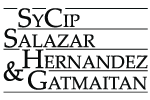Back to Work Amidst COVID-19
January, 2023 - Ronald Mark Lleno, Ara Patrice P. Rillera
Under the Labor Advisory, employers are urged, in consultation with the employees or employee’s representative if any, to adopt and implement an appropriate paid isolation and quarantine leave program on top of existing leave benefits under a company policy, a Collective Bargaining Agreement, the Labor Code, and special laws. The paid isolation and quarantine leaves shall be without prejudice to other benefits provided by the Social Security System and the Employees’ Compensation Commission.
Employees falling under the definition of close contact, suspect, probable, or confirmed case shall complete the home-based or facility-based quarantine or isolation period in accordance with the prevailing issuances of the relevant government agencies, specifically of the DOLE, the Department of Health (“DOH”), and the Department of Trade and Industry (“DTI”).
The definitions of the different classifications under the COVID-19 Surveillance System, as provided in DOH issuances, are as follows:
- Suspect– a person who presents symptoms and has traveled or worked in an area with community or high risk of transmission within 14 days prior to symptom onset.
- Probable– a person who meets the clinical criteria above and is a contact of a probable or confirmed case or with chest imaging findings suggestive of COVID-19. Also included is a person with recent onset of anosmia (loss of smell) or ageusia (loss of taste) in the absence of any other identified cause.
- Confirmed– a person who tested positive for COVID-19, irrespective of the presence or absence of clinical signs and symptoms.
Close Contacts– shall refer to persons who have experienced any one of the following exposures during the two days before and the 14 days after the onset of symptoms of a suspect, confirmed, or probable case. Exposure shall be any of the following: [a] face-to-face contact with a confirmed case within one meter and for more than 15 minutes, with or without a mask; [b] direct physical contact with a confirmed case; [c] direct care for a patient with probable or confirmed COVID-19 with probable or confirmed COVID-19 disease without using Personal Protective Equipment (PPE); or [d] other situations as indicated by local risk assessments.
The difference between isolation and quarantine is provided in DOH Department Memorandum No. 2020-0439 dated October 6, 2020, titledOmnibus Interim Guidelines on Prevention, Detection, Isolation, Treatment, and Reintegration Strategies for COVID-19.Isolation refers to the separation of sick people with a contagious disease from people who are not sick. Therefore, isolation intends to treat and monitor suspect, probable, and confirmed cases.Quarantine refers to the separation and movement restrictions of people who were exposed to a contagious disease to see if they become sick. Hence, quarantine intends to keep individuals under observation to see if they will develop COVID-19 signs or symptoms or if they will test positive for COVID-19.Continue readingfull bulletinhereor via thislink.
Link to article


 Post a comment
Post a comment Print article
Print article

